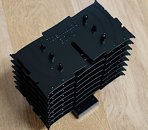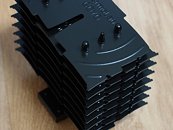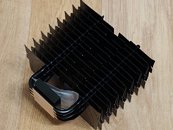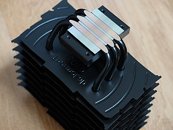Monday, December 30th 2013
ThermoLab GOYO CPU Cooler Pictured
ThermoLab, of the BARAM and BADA fame, posted pictures of its next CPU heatsink, named GOYO. This tower-type heatsink may look big in the pictures, but measures just 125 mm x 70 mm x 135 mm, weighing in at just 290 g. It features just 15 asymmetrically shaped aluminium fins, arranged along three 6 mm-thick copper heat pipes that make direct contact with the CPU at the base. Thermolab claims that the GOYO should be able to handle thermal loads of up to 60W fan-less. It can hold on to a pair of 120 mm fans. With its fans installed, the heatsink can handle chips with TDP of up to 95W. The cooler can handle most modern CPU socket types, including LGA1150/LGA1155, AM3+ and FM2+. Thermolab didn't finalize pricing or availability of the GOYO. Find a quick cooling performance preview at the source.
Sources:
Parkoz, FanlessTech




16 Comments on ThermoLab GOYO CPU Cooler Pictured
Cool looking cooler but properly a under preformer that i would only use for its looks
heatpipes will be its biggest issue. 3 6mm pipes will not be able to remove the heat from the latest hot running cpu.
Cyborg eyes from the future?, that can see and measure a few microns thickness, that i cant even measure with my caliper.
and its like the other cooler, just have fins variation
First of all how would adding a layer of material add on to the surface area? Surface area is strictly the total area of the fins. Paint does little to increase or decrease performance actually, wither you use thermal specialized paint or not.
Look no soldering at all, really, no kidding, seriously, none at all. :wtf:
Want more proof, look here. :twitch:Actually Yes...
Heat gets transfered by infrared waves, and black is the best color that transfers that, just as a black surface absorb's more heat it also radiate it more if the source is gone.
Didn't notice that it's using this type of manufacturing, which yes would mean that soldering is no longer a problem. However, performance will be greatly depend on their manufacturing process and seeing if they can keep the stacks tight through transport ect.
But back to infrared dissipation, I truly don't believe that coolers this size could benefit much from the black surface. Probably in a large scale pure passive heatsink for industrial machines. I'm guessing that if the black is as good as absorbing heat from the fins, it will also absorb heat within the PC chassis. The way that some thermal paints are designed, is to prevent external heat to enter the fins.
(That's what Phanteks says theirs does: phanteks.com/PH-TC14PE.html)